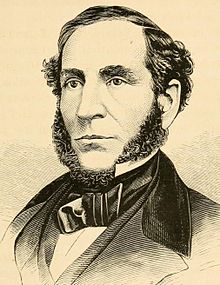This is an old revision of this page, as edited by Parkwells (talk | contribs) at 02:24, 23 May 2016 (→Personal life: add). The present address (URL) is a permanent link to this revision, which may differ significantly from the current revision.
Revision as of 02:24, 23 May 2016 by Parkwells (talk | contribs) (→Personal life: add)(diff) ← Previous revision | Latest revision (diff) | Newer revision → (diff)| George Whitfield Scranton | |
|---|---|
 | |
| Member of the U.S. House of Representatives from Pennsylvania's 12th district | |
| In office March 4, 1859 – March 24, 1861 | |
| Preceded by | Paul Leidy |
| Succeeded by | Hendrick Bradley Wright |
| Personal details | |
| Born | (1811-05-11)May 11, 1811 Madison, Connecticut, US |
| Died | March 24, 1861(1861-03-24) (aged 49) Scranton, Pennsylvania |
| Political party | Republican |
| Relations | Joseph A. Scranton (second-cousin) |
George Whitfield Scranton (May 11, 1811 – March 24, 1861) was an industrialist and politician, a Republican member of the U.S. House of Representatives from Pennsylvania from March 4, 1859, until his death in 1861. Moving from Connecticut to Pennsylvania in the late 1830s, he was the founder of the city of Scranton, Pennsylvania, where he established the Lackawanna Iron and Coal Company. He became a major industrialist, leading two railroad companies.
After his death, his cousin's son, William Walker Scranton, became general manager of the Iron & Coal Company, serving during the Scranton General Strike of 1877.
Early life
George Scranton was born in Madison, Connecticut. Among his siblings was his brother Selden T. Scranton. He attended Lee’s Academy. He moved to Belvidere, New Jersey, in 1828 and became a teamster.
Career

From 1835 to 1839, Scranton was interested in agricultural pursuits.
He and his brother Selden became interested in new developments in industry and moved to northeast Pennsylvania, in an area of mining of anthracite coal. Together with Sanford Grant and Philip H. Mattes, they formed the firm of Scrantons, Grant & Company. Mattes was head of a branch of a bank in Easton, Pennsylvania.
In 1839 Scranton started manufacture of iron, and began experimenting with the practicability of smelting ore by means of "hard" or anthracite coal in Slocum (now Scranton, Pennsylvania). This area became the center of extensive mining of anthracite coal.
Scranton was the founder of the Lackawanna Iron & Coal Company, named after the river. He and his brother Selden, together with Grant and Mattes, are considered founders of the city of Scranton, named after him. He constructed the Northumberland division of the Lackawanna Railroad. He was the president of two railroad companies.
Politics
Scranton was elected to Congress from Pennsylvania as a Republican in 1858 to the 36th Congress and served from March 4, 1859, until his death in Scranton on March 24, 1861.
Personal life
In 1847, his cousin Joseph a. Scranton moved with his second wife and young family to this corner of Pennsylvania. One of his sons, William Walker Scranton, went to Yale in the family tradition, later becoming general manager of the Lackawanna Iron & Coal company. He led the company during the extensive protests and action in the city in 1877 during the Scranton General Strike.
Sources
- United States Congress. "George W. Scranton (id: S000191)". Biographical Directory of the United States Congress.
External links
| U.S. House of Representatives | ||
|---|---|---|
| Preceded byPaul Leidy | Member of the U.S. House of Representatives from Pennsylvania's 12th congressional district 1859–1861 |
Succeeded byHendrick B. Wright |
This article about a member of the United States House of Representatives from Pennsylvania is a stub. You can help Misplaced Pages by expanding it. |
This biography related to rail transport in the United States is a stub. You can help Misplaced Pages by expanding it. |
- Frederick Lyman Hitchcock, History of Scranton and Its People, Volume 1, 1914, p. 8
- Hitchcock (1914), History of Scranton, p. 9
- Members of the United States House of Representatives from Pennsylvania
- American manufacturing businesspeople
- 19th-century American railroad executives
- 1811 births
- 1861 deaths
- Scranton, Pennsylvania
- Pennsylvania Republicans
- People from Belvidere, New Jersey
- American steel industry businesspeople
- Republican Party members of the United States House of Representatives
- 19th-century American politicians
- Pennsylvania United States Representative stubs
- American rail transportation biography stubs